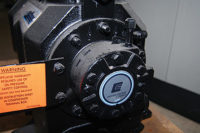The crankshaft is actually connected to the oil pump and supplies power, which turns the oil pump.
Oil pumps can be of the gear or eccentric type (Figure 2). The oil pumps force oil through drilled holes in the crankshaft and deliver it to bearings and connecting rods. The oil then drops to the crankcase to be picked up again by the oil pump.
Smaller compressors usually have some type of splash type oiling system. These systems have an oil scoop that scoops and flings the oil throughout the crankcase, causing an oil fog as the crankshaft turns.
When dealing with compressors that employ an oil pump, many service technicians confuse net oil pressure with oil pump discharge pressure. However, it is of utmost importance that service techs understand the difference between these two pressures when servicing compressors with oil pumps.
The oil pump’s rotating gear or eccentric adds a certain pressure to the oil pumped through the crankshaft. This pressure is considered “net” oil pressure. Net oil pressure is not the pressure that can be measured at the discharge of the oil pump. The oil pump picks up oil (at crankcase pressure) from the compressor’s crankcase through a screen or filter (Figure 3).
The oil pump discharge port’s pressure includes both crankcase pressure and oil pump gear pressure it adds to the oil. This is why net oil pressure cannot be measured directly with a gage. A gage at the oil pump’s discharge port would register a combination of crankcase pressure and oil pump gear pressure.
The technician must realize this and subtract the crankcase pressure from the oil pump discharge port’s pressure to get the net oil pressure. Equation 1 shows how to do this:
(Oil pump discharge pressure) – (Crankcase pressure) = (Net oil pressure)
For example: The oil pump discharge pressure is 80 psig. The crankcase pressure is 20 psig. What would be the net oil pressure?
Solution: Subtract the crank-case pressure from the oil pump discharge pressure to get the net oil pressure; that is, (80 psi) - (20 psi) = 60 psi net oil pressure. This means the oil pump is actually putting 60 psi of pressure into the oil when delivering it into the crankshaft’s drilled passages.
This is why oil safety controllers are called differential-type controllers. They sense the difference between oil pump discharge pressure and crankcase pressure. This is why these controllers have a capillary tube or pressure transducer connected to the discharge of the oil pump and the crankcase to sense a difference of pressures or “net oil pressure” (Figures 4 and 5).
(Author’s note: Oil safety controller types and their circuitry will be covered in next month’s column.)
Net oil pressures vary from compressor to compressor, usually ranging from 20 to 40 psi. Most oil pressure safety controllers will shut the compressor down if the net oil pressure falls below 10 psi.
Variables that effect the net oil pressure include:
Larger compressors need more net oil pressure because they have more surface areas to lubricate. The oil pumps must also pump and carry the oil greater distances within the larger compressor.
Also, as the oil gets hotter and its viscosity drops, the net oil pressure also usually drops. As a compressor wears, its tolerances become greater and easier for the oil to escape through its clearances.
VACUUM MEASUREMENTS
Sometimes the compressor’s crankcase may be operating in a vacuum. In this case, the crankcase pressure is negative. (Remember that every 2 in. of mercury vacuum is equivalent to 1 psi.)For example:What is the net oil pressure if the oil pump discharge pressure is 35 psig and the crankcase pressure is 6 in. of vacuum (-3 psi)?Solution:Again, using Equation 1, we must subtract the crankcase pressure from the oil pump discharge pressure to get the net oil pressure. (Oil pump discharge pressure) - (Crankcase pressure) = (Net oil pressure) (35 psi) - (-3 psi) = 38 psi of net oil pressure. This means that the oil pump is delivering 38 psi of net oil pressure through the crankshaft and bearings.Tomczyk is a professor of hvacr at Ferris State University, Big Rapids, MI.
Publication date: 01.08/2001





